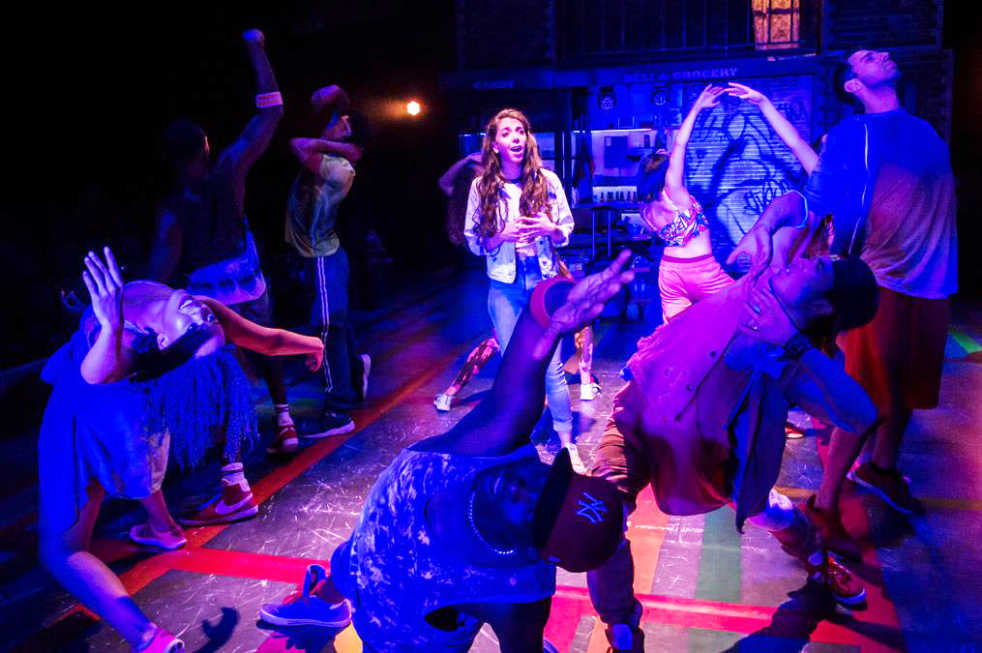To get it out of the way early: no, “In the Heights” is not “Hamilton,” but there are two important caveats, in case that statement causes any disinterest.
First, unlike its newer and more topical sibling, a non-New Yorker who would prefer to buy food for a month can experience “In the Heights” with little to no hardship involved. Second, “In the Heights” is just as adept at convincing viewers to care about stories they had seldom, if ever, considered. Similarities abound in the stories themselves, including their execution.
The story, for its part, manages to be both universally relatable and unabashedly about the Hispanic immigrant’s experience in New York. This duality is almost certainly the point, but any meta-commentary on the theatergoing community comes second to the captivating group of characters.
Usnavi, an orphaned young man who now runs a corner grocery, dreams of both the Dominican Republic of his roots and the girl who works across the street. Vanessa, the girl in question, is trapped in the barrio, working a menial job but longs to be Downtown and away from her alcoholic mother. The neighborhood’s mother figure, Abuela Claudia, acts as the resident metaphor for enjoying simpler pleasures of a bygone era. Nina, who at the beginning of the show has returned from her first year at Stanford, possesses a secret that puts her at odds with her parents.
Moments of emotional heaviness interplay deftly with comic relief by characters such as Sonny and Graffiti Pete — who is also an adept breakdancer — and Piragua Guy, who offers a real shaved ice to a lucky audience member in the front row.
The cast all bear uncanny auditory likenesses to their predecessors in the original Broadway cast. When Diego Klock-Pérez begins the opening number as Usnavi, muted gasps can be heard scattered throughout the audience, as though Lin-Manuel himself is somehow onstage. All of the main actresses are similarly gifted, though Klock-Pérez is most obviously trying to channel another actor’s interpretation. Since Klock-Pérez is both as charming as Miranda and arguably a better singer, the strategy pays off.
The company obviously benefitted from shifting up to a larger stage from the Aurora Theatre in Lawrenceville, which offered an appropriate intimacy but lacked enough room for the choreography that makes songs like “96,000” so impressive to watch.
The Rialto’s lighting effects are equally impressive, with smooth transitions and a smart setup that occasionally casts the ensemble’s shadows off the sides of the stage and onto the walls. This effect extends the undeniable kinetic energy into the audience. The stage pieces themselves are remarkably detailed with clever elements that fold out to reveal the interiors of shops and businesses.
Miranda’s music shines, as one seeing the show in a post-“Hamilton” world would expect. “In the Heights” and “96,000,” songs’ incorporation of hip-hop elements will garner comparisons to the “Cabinet Battle” songs. While they are far less technically impressive, these two songs accomplish an entirely different feat of switching languages within a matter of seconds.
The intimate knowledge of rhyming and rhythmic structures, which make Hamilton so engaging to listen to, are present in its earlier cousin, applied to fewer SAT words and more rhyming interpolations of languages (“and after mañana, mi pana/ya gotta just keep watchin’”).
Perhaps as a testimony to the broader, ensemble-focused nature of “Heights,” relatively minor characters such as Abuela Claudia and Nina’s parents get their own songs and chances to relay different perspectives of the same events. The showstoppers are undeniably the songs in which the entire company is contributing onstage together. However, individual songs and duets like “When the Sun Goes Down” and “Paciencia y Fe” best showcased the imperfect humanity that Miranda is uncannily good at expressing in words.
Instrumentally, there are prominent influences from boleros and salsa music, often changing in tone and modernity to adapt to the age and background of each character — Vanessa’s songs are fluttery and flirtatious, while older parent figures are bound to more slower tempos and sombre ballroom pieces.
Boleros and salsa music are prominent influences of the soundtrack. Oddly enough, the early-2000s pop and Broadway hybrid sounds uncannily like moments from “High School Musical” in its best form. The “hydrants are open” melody from “Finale” is extraordinarily beautiful and reminiscent of “Everyday” from “High School Musical 2”.
It is the audience of “High School Musical” that ideally might enjoy “In the Heights” the most. The adult jokes that are present will fly over children’s heads. If the premise does not deter an adult from attending, the musical does not contain anything more radical or progressive to be “offended” by.
Millennials, however, will understand Nina’s frantic worries about college in “Breathe” all too well, just as they will identify with Usnavi’s anxious word-vomit around Vanessa. In a
relatable way, almost every character desires to “get out” and be
in a romanticized place where they belong.
With long overdue representation, Hispanic millennials may have the most personal experience with “In the Heights,” but the overarching theme of joy and gratitude in the face of hardship speaks to all audiences.
“In the Heights” will be playing at the Rialto through Sep. 18. Tickets start at $20. The Rialto Center for the Arts is only a short walk or drive from campus, across from Woodruff Park.
